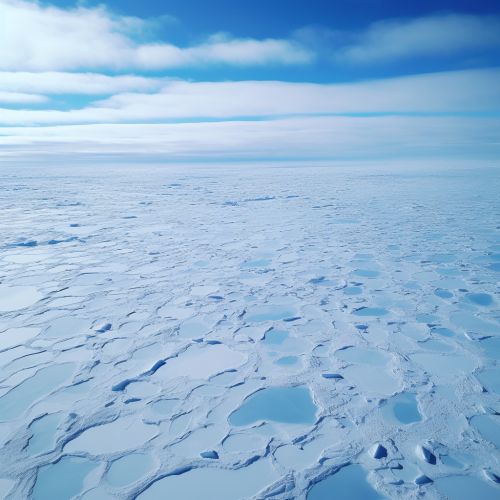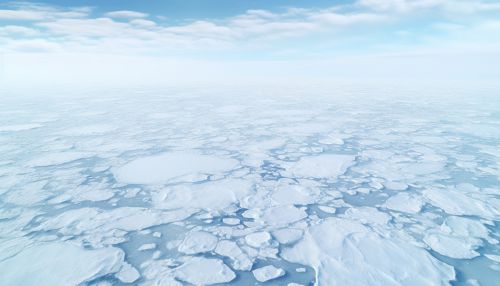Multi-year ice
Overview
Multi-year ice is a type of sea ice that has survived at least two summer melt seasons. This type of ice is typically thicker, harder, and rougher than first-year ice, with a mean thickness that can exceed 3 meters. Multi-year ice is characterized by its unique physical properties, which include a lower salt content and a higher air bubble content compared to first-year ice. These properties affect the ice's optical and thermal characteristics, as well as its response to mechanical stress.


Formation and Characteristics
Multi-year ice forms when first-year ice does not completely melt during the summer. As the ice survives through multiple melt seasons, it undergoes a process of thermodynamic growth. This process involves the gradual expulsion of brine, which results in a decrease in the ice's salt content and an increase in its air bubble content. The ice also becomes thicker and rougher due to the effects of ice deformation and ridging.
The unique physical properties of multi-year ice have important implications for its behavior and interactions with the environment. For example, the lower salt content of multi-year ice means that it has a higher melting point than first-year ice. This makes multi-year ice more resistant to melting and contributes to its longevity. The higher air bubble content of multi-year ice affects its optical properties, causing it to appear whiter and more reflective than first-year ice. This increased reflectivity, or albedo, plays a crucial role in the Earth's energy budget by reflecting sunlight back into space and helping to regulate the planet's temperature.
Role in the Arctic Ecosystem
Multi-year ice plays a vital role in the Arctic ecosystem. It provides a stable platform for Arctic wildlife, including polar bears, seals, and various species of Arctic birds. These animals rely on the ice for hunting, breeding, and resting. Multi-year ice also supports a diverse community of ice algae, which forms the base of the Arctic food web.
In addition to its ecological role, multi-year ice also influences the physical environment of the Arctic. Its high albedo helps to regulate the Arctic's temperature by reflecting sunlight back into space. This cooling effect is crucial for maintaining the stability of the Arctic climate. Multi-year ice also acts as a barrier that limits the exchange of heat, moisture, and gases between the ocean and the atmosphere.
Decline of Multi-Year Ice
In recent decades, there has been a significant decline in the extent and thickness of multi-year ice in the Arctic. This decline has been driven by a combination of warming temperatures and changes in wind patterns, which have increased the rate of ice melt and the export of ice out of the Arctic. The loss of multi-year ice is a major concern because of its potential impacts on the Arctic ecosystem and climate.
The decline of multi-year ice is also having significant implications for human activities in the Arctic. The reduction in ice cover is opening up new areas for shipping and exploration for oil and gas, which brings both opportunities and challenges. On one hand, these developments could bring economic benefits to Arctic communities. On the other hand, they also pose risks to the environment and to the traditional ways of life of Indigenous peoples.
